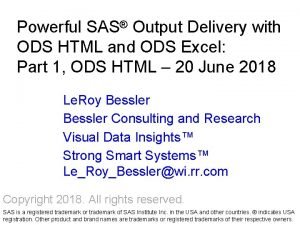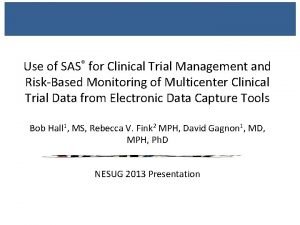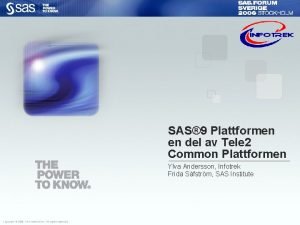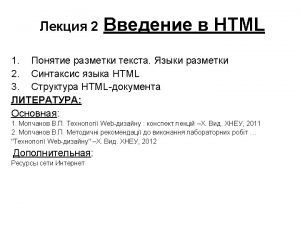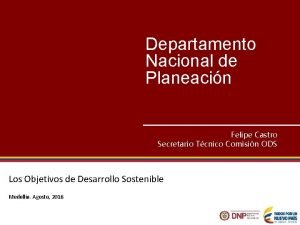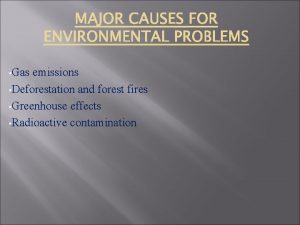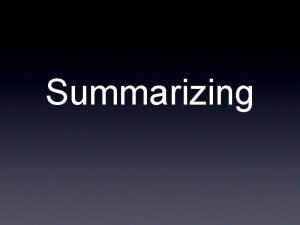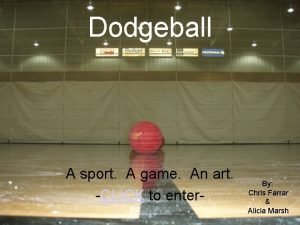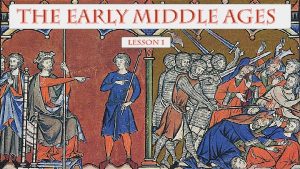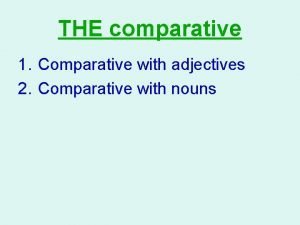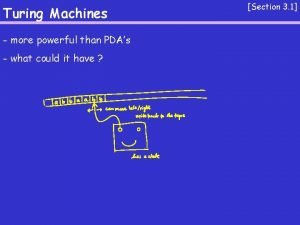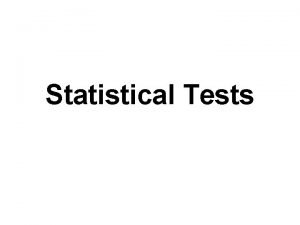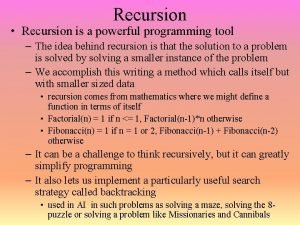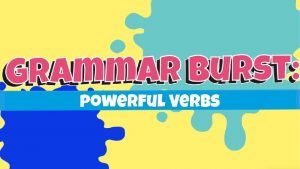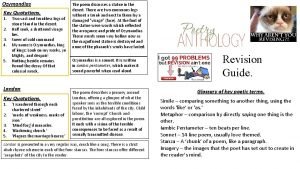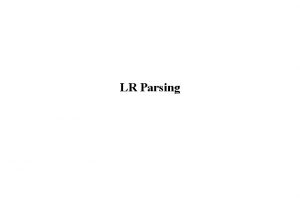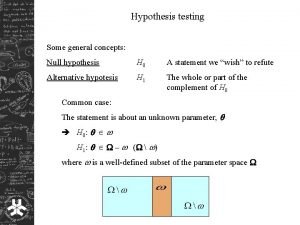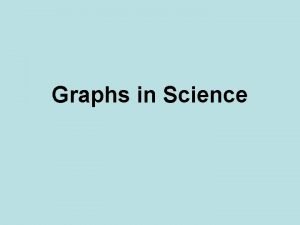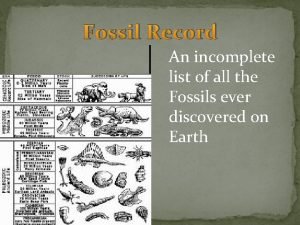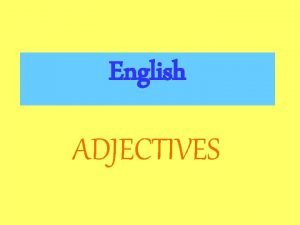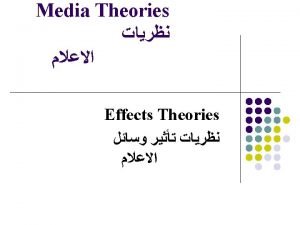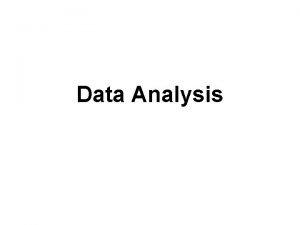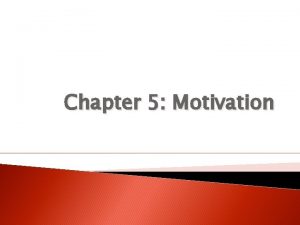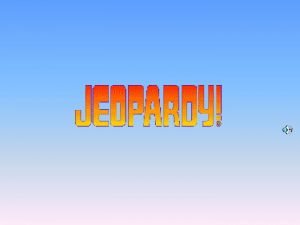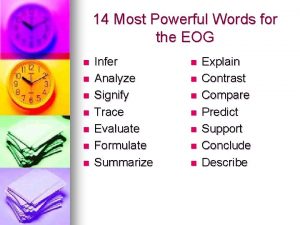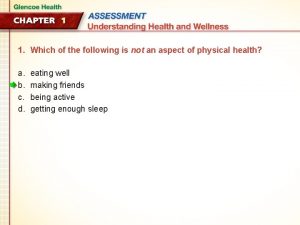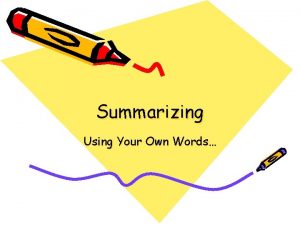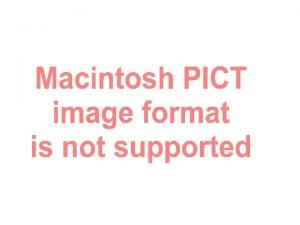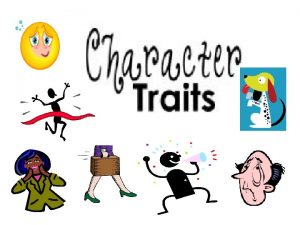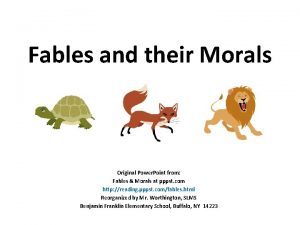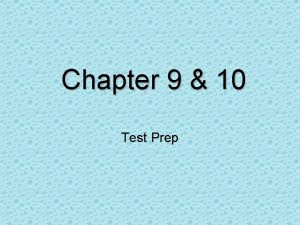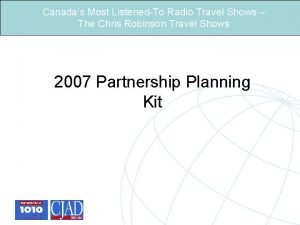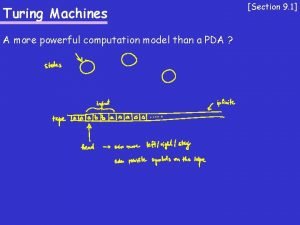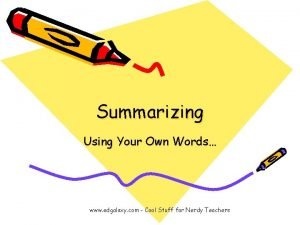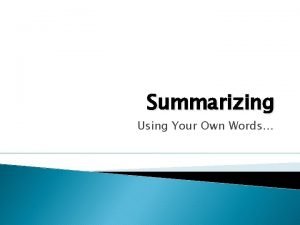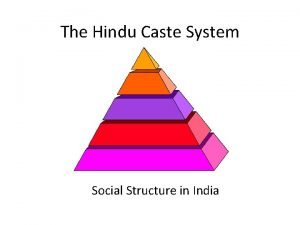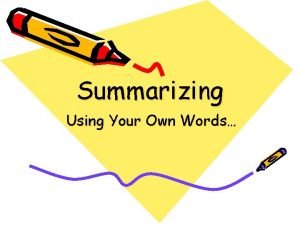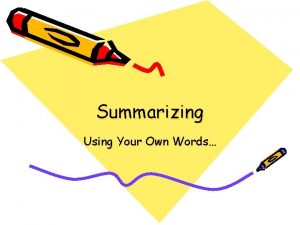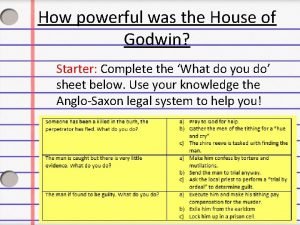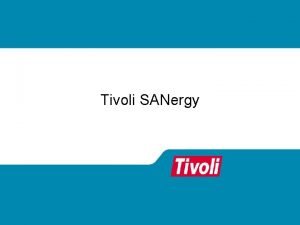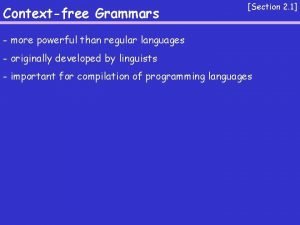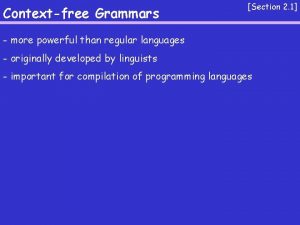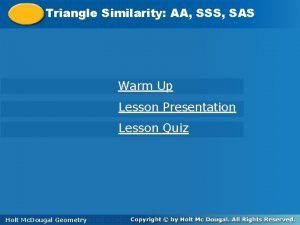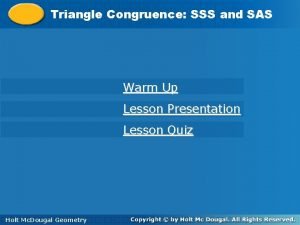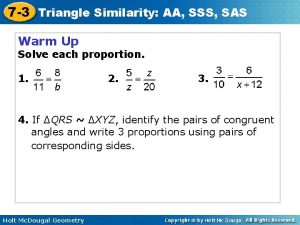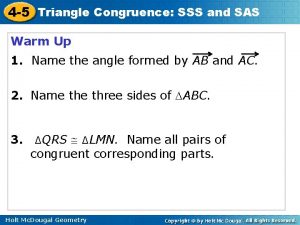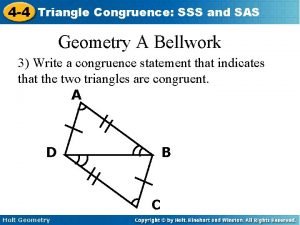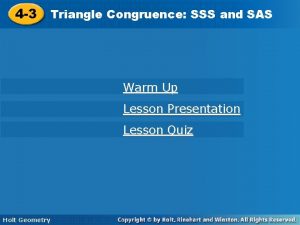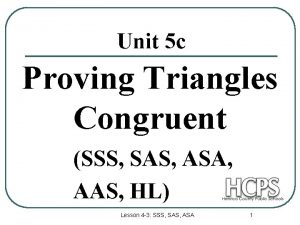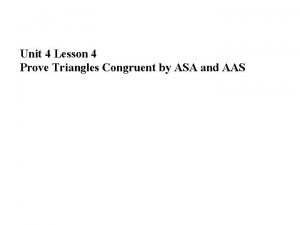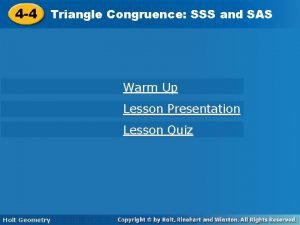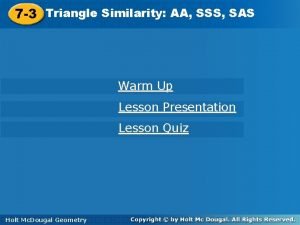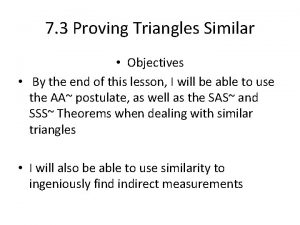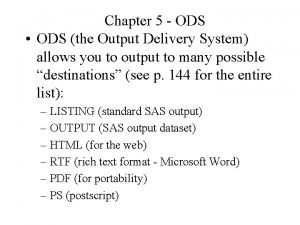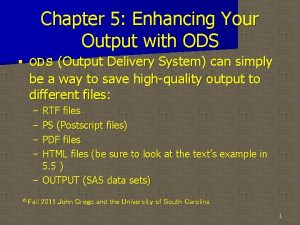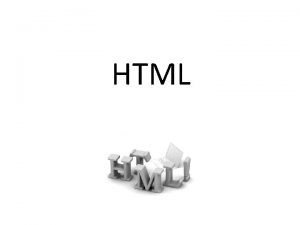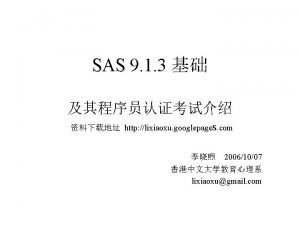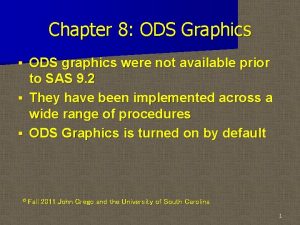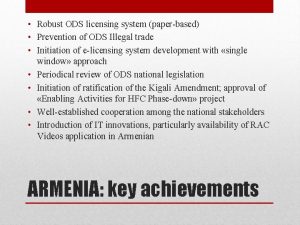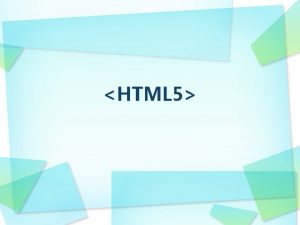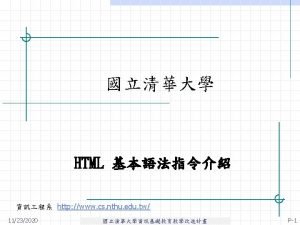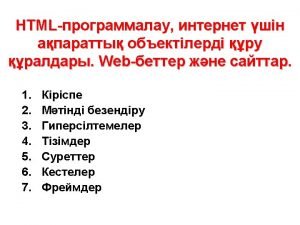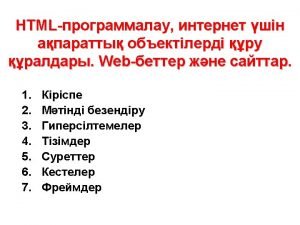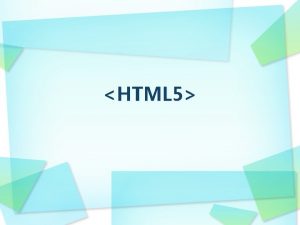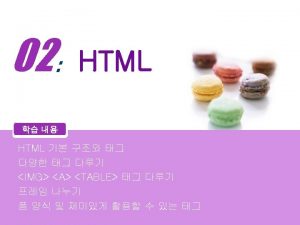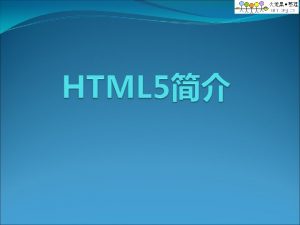Powerful SAS Output Delivery with ODS HTML and
































































































- Slides: 96

Powerful SAS® Output Delivery with ODS HTML and ODS Excel: Part 1, ODS HTML – 20 June 2018 Le. Roy Bessler Consulting and Research Visual Data Insights™ Strong Smart Systems™ Le_Roy_Bessler@wi. rr. com Copyright 2018. All rights reserved. SAS is a registered trademark or trademark of SAS Institute Inc. in the USA and other countries. ® indicates USA registration. Other product and brand names are trademarks or registered trademarks of their respective owners.

Communication-Effective Web Design The Short List (See also the paper) 1. Plain solid backgrounds that offer high contrast with text and numbers. White is always OK. 2. Colored text, numbers, & lines must be thick, colored plot point/markers and legend samples must be big. This is relevant for any graph or table, web-deployed or not. 3. For graphs, use ODS HTML. . . GTITLE GFOOTNOTE 4. Size graphs so that they require no scrolling NOTE: ODS Styles other than Minimal, have no communication value. They are decoration.

Screen Captures Google Chrome as web browser 1920 X 1080 screen resolution

Basic Syntax ods html path="Your. Path" (url=none) /* relocatable results */ body="Your. File. Name. html" style=Minimal gtitle gfootnote /* doing a graph */ ; < your code here > ods html close; /* default style in recent SAS versions is HTMLBlue */

Common Framing %let Path = C: ! ! ! ODS HTMLresults; ods results off; /* not opening result in SAS session */ ods _all_ close; < ODS HTML Code Block goes here > ods results on; /* so later processing can open results in this same SAS session, unless results turned off */

- Some code is omitted - The paper contains more code - All code available via email request

Default Web Table

Default Web Table proc summary data=sashelp. shoes nway; class region; var sales; output sum= out=work. Shoe. Sales. By. Region(drop=_type_ _freq_); run; ods html path="&Path" (url=none) body="Demo 1. html"; title 1 height=32 pt color=black 'Demo 1. . . '; title 2 height=32 pt 'Default. . . '; title 3 height=32 pt 'Its. . . '; title 4 height=32 pt 'Its. . . '; title 5 height=32 pt 'Its. . . '; proc print data=work. Shoe. Sales. By. Region noobs; run; ods html close;

Customized Web Table

Customized Web Table %let Title = Demo 2 - Customized Web Table. . . ; ods html path="&Path" (url=none) body="Demo 2. html" (title="&Title"); /* The above Title text appears in the web browser title bar */ title 1 height=32 pt font='Arial/Bold' "&Title"; title 2 height=32 pt font='Arial/Bold' color=blue 'Fonts: . . . '; proc print data=work. Shoe. Sales. By. Region noobs style(header)={font_size=32 pt font_face='Arial' font_weight=bold} style(data) ={font_size=32 pt font_face='Arial'}; run; ods html close;

The Web Browser Title Bar

Using ODS Style Minimal

Using ODS Style Minimal ods html path="&Path" (url=none) body="Demo 2. html" (title="&Title") style=Minimal; /* The benefit of ODS styles other than Minimal is decoration, not communication */

Custom Web Graph

Custom Web Graph – HTML “frame” %let Title = Demo 4 - Bar Chart Of Shoe Sales By Region; ods html path="&Path" (url=none) style=Minimal gtitle /* title(s) inside the image, not in the html source */ body="Demo 4. html" (title="&Title"); title 1 height=32 pt font='Arial/Bold' "&Title"; < graph code here > ods html close;

Custom Web Graph – Graph Preliminary proc catalog cat=work. gseg kill; run; quit; * If rerun during same session, SAS/GRAPH can reuse the graph name. For a batch run, which runs this once, this is not needed. */

Custom Web Graph – Graph Creation goptions ftext='Arial' htext=32 pt; goptions xpixels=1200 ypixels=900; /* my monitor 1920 X 1080 */ proc gchart data=sashelp. shoes; axis 1 style=0 label=none; axis 2 style=0 label=none major=none minor=none value=none; hbar Region / sumvar=Sales name='Sales. In. Each. Region' /* graph filename */ descending discrete noframe coutline=same maxis=axis 1 raxis=axis 2 width=2 space=2 sumlabel='Dollars'; run; quit; /* NOTE: Default graph filetype is PNG */

Screen Captured Web Graphs Graph mages were created with goptions xpixels=1200 ypixels=900; My monitor resolution is 1920 X 1080, so the web graph display has lots of white space at both sides.

Target Folder File Content for Web Graph Demo 4. html Sales. In. Each. Region. png

Horizontal Bar Chart Design Tip Unless a huge number of bars, e. g. , all fifty states of USA, and you want easy alphabetic lookup, order bars by size: descending if big=good ascending if small=good. In that case, maybe offer both alphabetic and by size. If web graphs, interlink them.

Summary Graph Linked to Detail Graphs

Detail Graph Linked Back To Summary

Summary Graph Links to Detail Web Pages %macro Link. Vars; %do h = 1 %to &Region. Count %by 1; if Region EQ "&&Region&h" then Link. Var = 'href="' || "Demo 5_Bar. Chart. Of&&Region. Filename&h. . . html" || '"'; %end; %mend Link. Vars; data work. Sales. Data. With. Links; length Link. Var $ 100; set work. Sales. By. Region. By. Product; %Link. Vars; run;

Summary Graph Creation Using Link. Var proc gchart data=work. Sales. Data. With. Links; hbar Region / sumvar=Sales name="Sales. By. Region" html=Link. Var < other options > ; run; quit;

Detail Graph Links to Summary Web Page title 2 height=30 pt font='Arial/Bold' color=blue underlin=2 /* underlin=1 underline would be too thin */ link="Demo 5. html" "Click here to go back to Shoes Sales By Region" ;

Summary Web Table Links to Detail Tables

Detail Web Table Linked Back To Summary

Summary Web Table Links to Detail Tables data work. Shoe. Sales. By. Region. With. Links; length Region $ 100 Region. For. Filename $ 32; ; set work. Shoe. Sales. By. Region; Region. For. Filename = translate(trim(Region), '__', ' /'); Region= '<A ' || compress('HREF="Demo 6_Table. Of' || Region. For. Filename||'. html') || '">' || trim(Region) || '</A>'; run; /* For graph links, give HREF assignment as value of HTMLVAR. For table links, imbed HTML anchor tags inside data set variable values. */

Detail Table Links to Summary Web Page title 2 height=32 pt font='Arial/Bold' color=blue underlin=1 /* underlin=1 is OK for web table links */ link="Demo 6. html" "Click here to go back to Shoes Sales By Region" ;

Two Tables in One Web Page

Scrolling Down to the Second Table

Two Tables in One Web Page proc summary data=sashelp. shoes; /* NO nway */ class region product; var sales; output sum= out=work. Sales. Summary(drop=_freq_); run; /* put two PROC PRINTs inside the code block */ ods html. . . ; title 1. . . ; proc print data=work. Sales. Summary. . . ; where _type_ EQ 2; var Region Sales; sum Sales; run; title 1. . . ; proc print data=work. Sales. Summary. . . ; where _type_ EQ 1; var Product Sales; sum Sales; run; ods html close;

Highlighting the Totals proc print data=work. Sales. Summary noobs style(header) =. . . style(data) =. . . style(grandtotal)= {font_size=32 pt font_face='Arial' font_weight=bold backgroundcolor=yellow };

ODS HTML Table of Contents for Tables

Main Panel Is Really Scrollable

Scrollable, but the Table of Contents Provides Short. Cut to any Item of Interest. Most Useful when Items are Very Many.

Close. Up of ODS HTML Table of Contents

ODS HTML Table of Contents ods html path="&Path" (url=none) style=Minimal body ='Ignore_This_Demo 8_body. html' contents='Ignore_This_Demo 8_contents. html' frame ='Click_Here_For_Demo 8. html' (title="Demo 8. . . "); /* For each table, code of this form: */ ods proclabel 'Shoe Sales. . . '; proc print data= contents='Click for Table'. . . ; run; ods html close;

ODS HTML Table of Contents for Graphs

ODS HTML Table of Contents for Graphs

ODS HTML Table of Contents ods html path="&Path" (url=none) style=Minimal body ='Ignore_This_Demo 9_body. html' contents='Ignore_This_Demo 9_contents. html' frame ='Click_Here_For_Demo 9. html' (title="Demo 9. . . "); /* For each graph, code of this form: */ ods proclabel 'Shoe Sales. . . '; proc gchart data=. . . ; hbar. . . / description='Click for Bar Chart'. . . ; run; ods html close;

ODS Table of Contents can be used for a mixture of tables and graphs

Many report users prefer a spreadsheet instead of a Web Table Results can be reformatted as they like Results can be used further as they like Using a tool that everyone has and knows See my companion paper also in the conference proceedings: Powerful SAS® Output Delivery with ODS HTML and ODS Excel: Part 2, ODS Excel

Interlinked Plot, Table, and Spreadsheet Note the Mouseover Text for Jeffrey

Mouseover Text for Jeffrey

Links to Table and Spreadsheet

Web Table With Link Back To Plot

Spreadsheet With Link Back To Plot

Creating the Table and Spreadsheet ods excel file="&PathDemo 10_Spread. Sheet. xlsx" options(sheet_name='SASHELP. CLASS Information' embedded_titles='yes' title_footnote_nobreak='yes') style=Minimal; ods html path="&Path" (url=none) style=Minimal body="Demo 10_Web. Table. html" (title="&Title"); title 1. . . ; title 2 height=30 pt justify=left font='Arial‘ color=blue underlin=1 link="Demo 10_Plot. html" "Go To Plot Of This Data"; proc print data=sashelp. class. . . ; run; ods _all_ close;

Preparing Mouseover Text for Plot data work. sashelp. Class. Data. To. Plot; length Alt. Text. Var $ 200; set sashelp. class; Alt. Text. Var = 'title="Weight in Lbs: ' || trim(left(PUT(weight, 5. 1))) || '0 D'X || 'Height in Inches: ' || trim(left (PUT(height, 4. 1))) || '0 D'X || 'Student: ' || trim(left (Name)) || '0 D'X || 'Age: ' || trim(left (PUT(Age, 2. ))) || '0 D'X || 'Sex: ' || trim(left (Sex)) || '"'; /* '0 D'X forces a line break */ run;

Creating the Plot title 1. . . ; title 2. . . ; title 3 h=31 pt color=blue underlin=2 link="Demo 10_Web. Table. html" "Go To Web Table Of This Data"; title 4 h=31 pt color=blue underlin=2 link="Demo 10_Spread. Sheet. xlsx" "Go To Spread. Sheet Of This Data"; ods html path="&Path" (url=none) style=Minimal gtitle body="Demo 10_Plot. html" (title='. . . '); proc gplot data=work. sashelp. Class. Data. To. Plot; plot weight*height / html=Alt. Text. Var . . . ; run; quit; ods html close;

Sending HTML-formatted email from SAS Even Plain Text Email from SAS supports: - address(es) for TO, CC, BCC - attachments HTML format supports imbedding in email body: - web table(s) - web graph(s) - stand-alone links

Sending HTML-formatted email from SAS 1. See the paper in the Proceedings for full code 2. For more information on SAS email, see the work of Erik Tilanus, who I call the International Post. Master General of SAS Email. E. g. , he has a 68 -page monograph Using SAS as Your Mail Room in the 2015 Wisconsin Illinois SAS Users Conference Proceedings at http: //www. wiilsu. org

Top of the Email Message

Bottom of the Email Message

Magnifying the upper left corner of email

Excerpting and magnifying hyperlinks in the email itself created with PROC ODSTEXT

For links in ODS outside of a table or graph /* specify the link with ^S={ url='. . . ' } */ ods escapechar="^"; proc odstext; p "^S={url='www. sas. com'} Go to SAS Institute Home Page"; p "^S={url='https: //support. sas. com/rnd/base/ ods/Tipsheet_List. Text. Blks. pdf'} SAS ODS List and Text Block Tip Sheet"; p "^S={url='file: ///C: /! ! ! ODS HTML/code'} Go To Folder of Code Used for This Paper"; run;

Magnifying the Graph

Magnifyied Email Header Too Fuzzy To Read Shows An Attachment Is Present

Images in next examples are not realistic, but were created expressly for exercises. They can be whatever you wish.

NOTE: When using images in web pages, they must be stored out on the world wide web, or must be on a disk accessible to anybody who will access your HTML file. If you use them to create a PDF, RTF, or Excel file with ODS, they are physically imbedded in the file.

Easy, But Unsatisfactory

Default Web Table proc print data=sashelp. class noobs style= {preimage = "&Img. Path. Image. Between. Titles. And. Table. gif" postimage = "&Img. Path. Image. Between. Table. And. Footnotes. gif"} . . . ;

Better, But More Coding

Better, But A Little More Coding proc print data=sashelp. class noobs Style = {prehtml = '<IMG src = "C: imagesImage. Between. Titles. And. Table. gif" vspace=15 >' posthtml = '<IMG vspace=15 src = "C: imagesImage. Between. Table. And. Footnotes. gif" >'}. . . ;

Now at top & bottom, but too far left

Best Example Positioning Options

Good Example Code proc template; define style Minimal. Imgs. Top. Bottom. Positioned; parent=styles. Minimal; class body / preimage ='C: imagesImage. At. Top. Of. Body. gif' prehtml ='<center>' /* center top image */ posthtml ="<img align=left hspace=570 /* shift right from left margin */ src='C: imagesImage. At. Bottom. Of. Body. gif'>"; end; run; title 1 height=16 pt ' '; /* space between top image and table because vspace does not work */ /* Space between footnote and bottom image occurs automatically. No code needed. */

Data-Dependent Images & Color-Coding Custom Text & Background Colors

Getting Fancy - Data-Dependent Images proc format; value ageimg 13 = '<IMG src = "C: imagesNew. Teen. Ager. gif" hspace=15 >' other = '<IMG src = "C: imagesAll. Other. Ages. gif" hspace=15 >'; run; /* in the PROC PRINT step */ var Age / style(header) = {. . . } style(data) = {. . . posthtml = ageimg. };

Getting Fancy – Data-Dependent Colors proc format; value $sexcolor 'F' = 'CXFFCCCC' /* very light red */ other = 'CXCCCCFF' /* very light blue */ ; run; /* in the PROC PRINT step */ var Sex / style(data) = {. . . background = $sexcolor. };

Custom Text Colors & Background Colors %let Font. Parms = font_size=32 pt font_face='Arial'; proc print data=sashelp. class noobs n style(header) = {&Font. Parms font_weight=bold} /* default for header of ALL non-ID variables */ style(data) = {&Font. Parms } /* default for data cells of ALL non-ID vars */ style(grandtotal) = { &Font. Parms font_weight=bold foreground=blue background=yellow } style(n) = { &Font. Parms font_weight=bold foreground=yellow background=blue }; id Name / style(header) = {. . . } style(data) = { &Font. Parms font_weight=bold foreground=yellow background=black vjust=center };

Getting Fancy – Unintended Consequences Displaying images inside data cells has unexpected effects on placement of text/numbers in those cells AND in cells of OTHER columns. The paper shows how to use just and vjust to adjust horizontal and vertical placement of text.

if not using NOOBS and an ID statement /* Options to use on PROC PRINT statement: */ style(obsheader) = { Whatever you like } style(obs) = { Whatever you like }

Animation - In the paper two examples use the gifanim device driver and SAS/GRAPH. - For how to do animation with ODS Graphics, do this Google search: sas animation "ods graphics" - Some hits are “Fun” but results have no real communication value. I have a bias for communication-effective data visualization.

USA Population Change By State By Census Decade 1790 to 2010 plus 2017 estimates The state populations, during each decade, are assigned to ranges and states are colored according to range.

USA Population Change By State Two Range Assignment Methods, Color Palettes - SAS/GRAPH PROC GMAP default - Le. RB design/method

SAS/GRAPH PROC GMAP default Range Assignment Method, Color Palette - six quantiles as trimmed ranges vary by decade - color palette is six shades of purple

SAS/GRAPH PROC GMAP default Color Palette: six shades of purple, in a gradient - “color gradient” use popular, not best choice - It can be difficult to reliably distinguish more than five shades of the same hue

Le. RB Custom Animated Map Range Assignment Method, Color Palette - twelve fixed ranges - color palette twelve easily distinguished colors and no Red-Green color blindness possibility (such blindness not exceedingly rate, despite regrettable popularity of “traffic lighting” method of data color-coding for bad vs good)

Le. RB Custom Animated Map Color Palette - No Red-Green color blindness possibility - Such blindness not exceedingly rare - Despite regrettable popularity of “traffic lighting” method of data color-coding for bad vs good

Two Range Assignments & Color Palettes The twelve fixed ranges method has the disadvantage of less granularity during the early decades when the populations were smaller. An alternative could accept the default range assignment of six trimmed quantiles, but specify the color palette as six distinct colors, not a color gradient of one shade.

Starting Map for Default Method

Ending Map for Default Method

Next slide runs the animation


Starting Map for Le. RB Method

Ending Map for Le. RB Method

Next slide runs the animation


Next, run one of my favorite animations Pop. Change in Chicago Area – made 2001


Conclusion More code detail is in the paper, and any demonstration or discussion thereof not included in this presentation. You can request via email: - a zip file of ALL code - the data used for animated maps - references for static maps

For more about ODS HTML (and other ODS destinations), see Output Delivery System: The Basics and Beyond, by L. E. Haworth, C. L. Zender, and M. M. Burlew published by SAS Institute Inc. in 2009. For later information, - try a Google search - go to support. sas. com, where, among other things, you can find a link to the relevant SAS Institute Inc. documentation.

For Your Requests, Suggestions, Comments, Questions, Solutions Le. Roy Bessler Ph. D Bessler Consulting and Research Visual Data Insights™ Strong Smart Systems™ Mequon, Wisconsin, USA Le_Roy_Bessler@wi. rr. com
 Ods html close
Ods html close Sas base programming course
Sas base programming course Ods tagsets.excelxp
Ods tagsets.excelxp The odds and ends kingdom
The odds and ends kingdom Sas information delivery portal
Sas information delivery portal Canvas доска
Canvas доска код страницы html
код страницы html Slidetodoc.com
Slidetodoc.com Doctype html html head
Doctype html html head 12.html?title=
12.html?title= Ods to pdf
Ods to pdf Ods to excel
Ods to excel Ods
Ods Asam ods 5
Asam ods 5 Ods cleveland state
Ods cleveland state Ods certificate customs format
Ods certificate customs format Ods
Ods Ods 5
Ods 5 Ods
Ods Sas no output destinations active
Sas no output destinations active What is the website to access accenture delivery suite(ads)
What is the website to access accenture delivery suite(ads) Sas tutors
Sas tutors Summarizingthis
Summarizingthis Esker
Esker Dodgeball
Dodgeball Constantinople trade routes
Constantinople trade routes Comparative with
Comparative with Semaphore provide a primitive yet powerful and flexible
Semaphore provide a primitive yet powerful and flexible Why did constantinople become a rich and powerful city
Why did constantinople become a rich and powerful city Fundamental and powerful concepts
Fundamental and powerful concepts Powerful african kingdoms
Powerful african kingdoms Tm is more powerful than pda
Tm is more powerful than pda Powerful effects theory
Powerful effects theory 5 powerful words
5 powerful words Statistical test flow chart
Statistical test flow chart Most powerful test
Most powerful test What is recursion can be a powerful tool for solving?
What is recursion can be a powerful tool for solving? Powerful verbs for walked
Powerful verbs for walked Powerful questioning
Powerful questioning Ozymandias key quotes and analysis
Ozymandias key quotes and analysis Strongest reducing agent
Strongest reducing agent Which of these is also known as look-head lr parser?
Which of these is also known as look-head lr parser? Limited effect theory
Limited effect theory Most powerful test
Most powerful test Manipulated variable and responding variable graph
Manipulated variable and responding variable graph A jackrabbit's powerful legs are an example of a
A jackrabbit's powerful legs are an example of a Un adjective
Un adjective Mass communication elements
Mass communication elements Powerful effects theory
Powerful effects theory A powerful tool in statistics
A powerful tool in statistics Employee motivation a powerful new model
Employee motivation a powerful new model Powerful military lords who headed small territories
Powerful military lords who headed small territories Eight powerful words
Eight powerful words Powerful words
Powerful words 12 most powerful words
12 most powerful words Experts think that poor health literacy influences
Experts think that poor health literacy influences A tornado is a powerful twisting windstorm
A tornado is a powerful twisting windstorm Disciplinary curriculum
Disciplinary curriculum Malala paragraph
Malala paragraph Why are line graphs powerful tools in science?
Why are line graphs powerful tools in science? Having a strong wish to be successful
Having a strong wish to be successful Formulate example
Formulate example Total energy formula
Total energy formula List of fable morals
List of fable morals The spoils system made political parties more powerful by
The spoils system made political parties more powerful by The most powerful daily from
The most powerful daily from Turing machine is more powerful than
Turing machine is more powerful than Www.edgalaxy.com-cool
Www.edgalaxy.com-cool A tornado is a powerful twisting windstorm
A tornado is a powerful twisting windstorm Elaboration techniques
Elaboration techniques Power full caste in india
Power full caste in india Caste indian
Caste indian A tornado is a powerful twisting windstorm
A tornado is a powerful twisting windstorm A tornado is a powerful twisting windstorm
A tornado is a powerful twisting windstorm Turing machine is more powerful than: *
Turing machine is more powerful than: * Why were the godwins so powerful
Why were the godwins so powerful Most powerful sans
Most powerful sans World powerful empire
World powerful empire Why did the shang rulers become powerful
Why did the shang rulers become powerful What muscle fibers run in circles around your eye
What muscle fibers run in circles around your eye Moral tale definition
Moral tale definition Cfgs are more powerful than:
Cfgs are more powerful than: Cfgs are more powerful than:
Cfgs are more powerful than: Building powerful numeracy
Building powerful numeracy How powerful was sparta
How powerful was sparta Triangle similarity: sss and sas quiz
Triangle similarity: sss and sas quiz 4-5 triangle congruence sss and sas
4-5 triangle congruence sss and sas Sss sas asa aas
Sss sas asa aas Triangle similarity: sss and sas assignment
Triangle similarity: sss and sas assignment 4-4 triangle congruence sss and sas
4-4 triangle congruence sss and sas What is sss in geometry
What is sss in geometry Triangle congruence sss and sas
Triangle congruence sss and sas 4-4 proving triangles congruent sss sas
4-4 proving triangles congruent sss sas Unit 4: congruent triangles
Unit 4: congruent triangles Lesson 4-4 triangle congruence sss and sas
Lesson 4-4 triangle congruence sss and sas Triangle similarity aa
Triangle similarity aa Proving triangles are similar
Proving triangles are similar
